Cuba: West to East
#1
FlyerTalk Evangelist
Original Poster
Join Date: Nov 1999
Programs: FB Silver going for Gold
Posts: 21,801
Cuba: West to East
Caution: Contains outdated advice as this trip was in April 2015
Note: This trip covers Matanzas, Havana, Pinar del Rio, Bahia de Cochineros, Cienfuegos, Trinidad, Camaguey, Manzanillo, Santiago de Cuba, Guantanamo (la cuidad, not la Bahia), Baracoa, Holguin and Gibara.
Why Cuba? Iconic without being kitschy and tacky, storied without being overrated. Woefully lacking yet proud, old and antiquated yet simply charming. Where there used to be simply no services for the non-resort bound visitor, there are now an overwhelming plethora of choices. Yet capacity is limited.
Going there before the Americans do
Like a lot of non-USA-ians, we decided to visit Cuba following Barack Obama’s announcement to seek normalisation of U.S. relations with Cuba in mid December 2014. A stampede of tourism apparently began with this. We saw lots of Germans (the majority – individually and in groups) and French with some Dutch, Argentinean and even Israelis travelling independently. Even an Australian seniors cycling group (no one under 70). For Havana, I’d say go before the Caribbean circuit cruise ships do. Casa particulares in late 2015 were reported to be charging in excess of CUC 100 a night, triple the rate of earlier in the year.
Getting there
4 April YLW-YVR-YYZ on various WS 737NGs
Not very glamorous. A motley collection of WS 737NG flights. YLW-YVR-YYZ with the last leg a dreadful short redeye (in the back not that WS has much of a front cabin). YYZ T3 on a Saturday morning is fairly hectic with vacation flights going apparently everywhere (Easter weekend probably didn’t help).
5 April YYZ-VRA and Matanzas
The transit in Toronto went fast. Noticed the passenger seated next to me from Vancouver was also getting on the flight and had met up with her party. There were others dressed in t-shirt uniforms so presumably headed to Varadero. The Westjet 737-800 flew over the Florida Keys just east of Key West providing a fine view of the end of the archipelago. Making landfall between Matanzas and Havana, we were surprised to see how uninhabited this part of Cuba apparently was, or at least the fact that Cubans don’t sprawl. Lots of farms and what we came to see as scrub land.
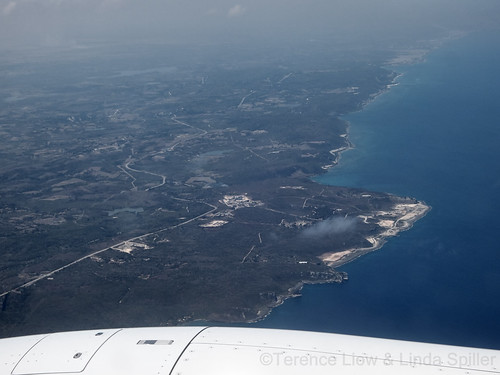
A WS 737 making landfall in Cuba just west of Matanzas
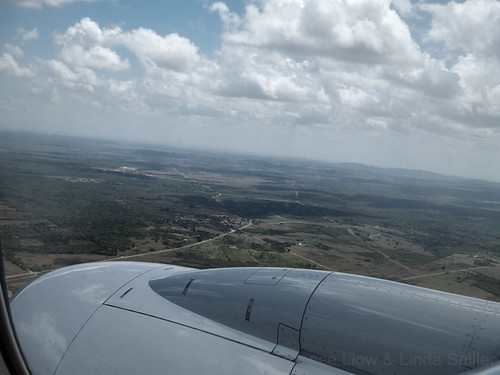
Cuban landscape south of VRA
Arrived at VRA, a single runway affair and we were a bit saddened to see a relatively-modern terminal with jetways: No grand disembarkation by air stairs here. Not extremely busy but it isn’t quiet either. Several flights from Canada daily in season with at least 4 Canadian operators. An Air Transat 330 was getting ready to push back just before some flight from Germany arrived (German flights also operate to Holguin where we would return from).
Entry into Cuba is easy. A tourism card, essentially a tourist tax, is necessary. No questions asked about where you stay now, just basic personal and passport data. The card is sold by most airlines or purchased at foreign embassies (some reportedly at exorbitant rates) but Canadian airlines make it easy but including one in the fare (YR CAD16).
Immigration isn’t too bad though the staff don’t work too fast. Customs isn’t onerous at all. Photo on entry seems to be in vogue here too but no fingerprinting yet. No questions asked at immigration other than if one had been to Africa recently (in which case you may need to prove Yellow Fever vaccination). The customs form had a few odd and ambiguously-worded questions such as unaccompanied bags (bit vaguely worded - could have meant if you checked bags – and value of goods you’re bringing in (should be more clearly worded to state only goods you’re buying as gifts and leaving behind). No questions asked upon exit as I doubt they want to scare off Canadians.
Then it’s out of the airport and up to you to do your own thing (you’re free to go almost anywhere and if there is anyone monitoring you, I never noticed).
First big line one encounters here is money exchange. The Cuban government has an essential legal monopoly on forex, either through Cadeca (CAsa DE CAmbio) or at state banks. The counter outside arrivals with a long line, but I peeked into the departure area and found an empty office fully staffed. Made it quick and easy get money and be on our way.
The casa particular failed to send a car so we inquired around. The taxi dispatcher quoted us CUC 25 to Matanzas which is what the CP car would have cost. Asked a taxi driver who quoted CUC 30 but we bargained him down to CUC 25. Some say that taxi particulars can be found outside the airport but none here but I did see the first classic car, a green Buick. The old taxis in the parking lot weren’t taking rides, probably deferring to the yellow and black official tax mafia.
Varadero airport is really in the middle of nowhere. Not one single building outside the airport area. No farms, villages, nothing. After a few kilometers, we got onto the Matanzas-Varadero highway, where there are some buildings, and began the drive into Matanzas. En route to the junction, we saw a couple that had been on the flight from Toronto walking to the highway junction. They must really be trying to travel cheap. Nice double-lane highway with hardly any traffic. I can see why this is said to be a driver’s paradise. The road is in better shape than some may have you believe. Sure, the rules of the road may be lax but no problem for a prudent and alert driver. No worse than most countries I have driven in including Italy, Austria, Argentina and even Philadelphia.
Cuba is very low density so while there is a bit if a sprawl outside Matanzas, it doesn’t slow you down since there is hardly any traffic and almost no traffic lights.
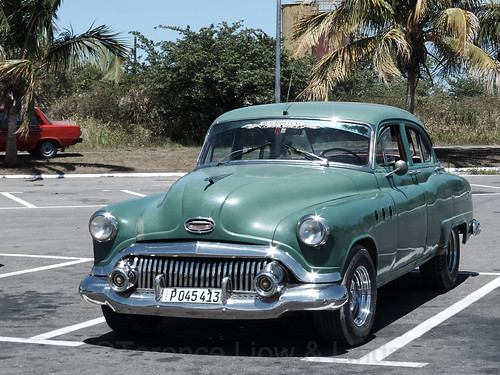 The first classic car
The first classic car
A Buick
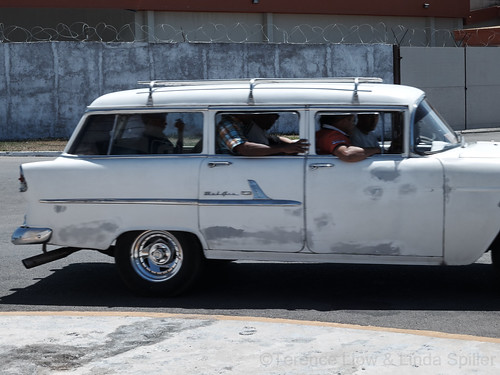 And the 2nd...
And the 2nd...
Chevy wagon ('55'-'57, I'm not good at the years as it was a little before my time)
Where to Stay
Cuba appears desperately short of quality accommodation (update: especially in Havana). You’ll notice that many properties outside of resorts can sell out quickly and are usually always highly-priced. Discounts may be given to tour operators who are guaranteed to give a steady level of business while retail prices are always high. The vast bulk of rooms are at resorts with the bulk of these in Varadero. While Havana has a fair amount of hotels. Government enterprises such as Cubanacan and Habaguanex in Havana are renovating, restoring or even essentially rebuilding scores of heritage buildings in the major tourism cities to increase capacity. Newer post-revolution properties not worthy of high-paying foreign tourists are operated by Islazul and <>. While aimed primarily at domestic tourists, they are also available to foreigners. Some can be gems of a bargain while others are best
avoided.
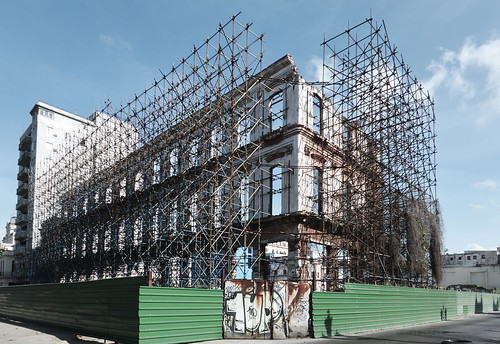 Buildng shell off the Malecon preserved for future restoration
Buildng shell off the Malecon preserved for future restoration
Casa Particulares.
The government must have decided that letting people rent out rooms, not more than 3 per house, to foreigners was not only a way to let people earn hard currency but also to expand tourism infrastructure (apparently not just for independent travellers but for small tour groups too). Owners (Cubans are allowed to buy and sell property these days, with a maximum of one primary residence and one vacation property) pay a reportedly-hefty fixed fee whether they have any renters or not. Prices are very reasonable (generally CUC 25-30 a night for 2 or maybe 3) with the owners being able to make higher-margin sales such as meals (breakfast from CUC 4-5 p.p. and dinner CUC 8-12), drinks and excursions.
While the CPs were usually spotlessly clean and had to have minimum standards (usually hot and cold water, fan, air conditioning and a fridge if not access to one), their quality varied greatly even within the same property with no or little difference in price.
Meals were generally very good and breakfasts were usually sumptuous with more than enough to tide one way past lunch.
With the reported fixed licensing fee/tax, and the apparent Cuban lack of awareness regarding reputation, some owners will overbook, or even sell your room when you have called to let them know you’ll be arriving in a day or two, and just deal with you when you arrive by sending you to a hopefully-nearby casa hopefully of friend or relative. To be fair, most reservations do not require any deposit so a no-show would result in total loss of revenue.
Update: According to a report at the end of 2015, CPs in Havana are reportedly asking in excess of CUC 100, triple the rate earlier in the year, due to high tourist demand with hotels already expensive in early 2015 and earlier often fully booked.
With the driver from Matanzas, we arrived at our CP pretty quickly where we were greeted by the proprietor Armando. He took us into his living room, open to the street as is Cuban style to register us. He then showed us our room, which was this 2 storey affair with a home-built concrete stairway going up to above the bathroom and kitchenette to the sleeping area. Just don’t sleep walk and fall off the platform. It was fine except the only window was a tiny stained glass one looking into the staircase going up to the roof. The sewage system, like everywhere else in Cuba, cannot handle toilet paper so you are asked to use the wastepaper basket. This was our introduction to CPs and to be aware of layout and to ask lots of specific questions.
We had dinner at Armando’s where we met the guest who had taken the nice room, a German who frequented Cuba a bit on contract from his government. He had
Jineteros
Local term for hustler. We expected to encounter lots especially in Havana but they’re not apparent so there must be a crackdown or we’re not attractive targets. Jineteras, the female equivalent, not quite a prostitute but could be considered as one, are said to frequent resort areas. Our guide told us that Camaguey is where there are many and where they come from. Sure enough, as soon as we stopped the car to walk around Camaguey, one came up to proposition our driver before we could even get out of the car.
It would appear that there was a bit more desperation as one went further east with more people asking for something. The usual was for taxi and pedicab rides, and cigars, but then one was solicited for restaurants.
Our encounter with our first jinetero was clearly with an amateur. Walking into the central plaza of Matanzas, we looked around the plaza and soon, this man came up to us giving us unsolicited information about the buildings we were looking at (which we could figure out by ourselves by reading the signs). He asked for money soon enough and was rather unfriendly when we told him we didn’t want his services.
Matanzas is a sleepy town but used to be a major port, and still has a refinery hence it is a tanker port of call. It is said that there are over a dozen galleons at the bottom of the bay all sunk by a single Dutch privateer. Some guide books deem it interesting and worth further exploration as it is said to be a hotbed of Afro-rumba music but early sleepers not in the know won’t find the places.
Note: This trip covers Matanzas, Havana, Pinar del Rio, Bahia de Cochineros, Cienfuegos, Trinidad, Camaguey, Manzanillo, Santiago de Cuba, Guantanamo (la cuidad, not la Bahia), Baracoa, Holguin and Gibara.
Why Cuba? Iconic without being kitschy and tacky, storied without being overrated. Woefully lacking yet proud, old and antiquated yet simply charming. Where there used to be simply no services for the non-resort bound visitor, there are now an overwhelming plethora of choices. Yet capacity is limited.
Going there before the Americans do
Like a lot of non-USA-ians, we decided to visit Cuba following Barack Obama’s announcement to seek normalisation of U.S. relations with Cuba in mid December 2014. A stampede of tourism apparently began with this. We saw lots of Germans (the majority – individually and in groups) and French with some Dutch, Argentinean and even Israelis travelling independently. Even an Australian seniors cycling group (no one under 70). For Havana, I’d say go before the Caribbean circuit cruise ships do. Casa particulares in late 2015 were reported to be charging in excess of CUC 100 a night, triple the rate of earlier in the year.
Getting there
4 April YLW-YVR-YYZ on various WS 737NGs
Not very glamorous. A motley collection of WS 737NG flights. YLW-YVR-YYZ with the last leg a dreadful short redeye (in the back not that WS has much of a front cabin). YYZ T3 on a Saturday morning is fairly hectic with vacation flights going apparently everywhere (Easter weekend probably didn’t help).
5 April YYZ-VRA and Matanzas
The transit in Toronto went fast. Noticed the passenger seated next to me from Vancouver was also getting on the flight and had met up with her party. There were others dressed in t-shirt uniforms so presumably headed to Varadero. The Westjet 737-800 flew over the Florida Keys just east of Key West providing a fine view of the end of the archipelago. Making landfall between Matanzas and Havana, we were surprised to see how uninhabited this part of Cuba apparently was, or at least the fact that Cubans don’t sprawl. Lots of farms and what we came to see as scrub land.

A WS 737 making landfall in Cuba just west of Matanzas

Cuban landscape south of VRA
Arrived at VRA, a single runway affair and we were a bit saddened to see a relatively-modern terminal with jetways: No grand disembarkation by air stairs here. Not extremely busy but it isn’t quiet either. Several flights from Canada daily in season with at least 4 Canadian operators. An Air Transat 330 was getting ready to push back just before some flight from Germany arrived (German flights also operate to Holguin where we would return from).
Entry into Cuba is easy. A tourism card, essentially a tourist tax, is necessary. No questions asked about where you stay now, just basic personal and passport data. The card is sold by most airlines or purchased at foreign embassies (some reportedly at exorbitant rates) but Canadian airlines make it easy but including one in the fare (YR CAD16).
Immigration isn’t too bad though the staff don’t work too fast. Customs isn’t onerous at all. Photo on entry seems to be in vogue here too but no fingerprinting yet. No questions asked at immigration other than if one had been to Africa recently (in which case you may need to prove Yellow Fever vaccination). The customs form had a few odd and ambiguously-worded questions such as unaccompanied bags (bit vaguely worded - could have meant if you checked bags – and value of goods you’re bringing in (should be more clearly worded to state only goods you’re buying as gifts and leaving behind). No questions asked upon exit as I doubt they want to scare off Canadians.
Then it’s out of the airport and up to you to do your own thing (you’re free to go almost anywhere and if there is anyone monitoring you, I never noticed).
First big line one encounters here is money exchange. The Cuban government has an essential legal monopoly on forex, either through Cadeca (CAsa DE CAmbio) or at state banks. The counter outside arrivals with a long line, but I peeked into the departure area and found an empty office fully staffed. Made it quick and easy get money and be on our way.
The casa particular failed to send a car so we inquired around. The taxi dispatcher quoted us CUC 25 to Matanzas which is what the CP car would have cost. Asked a taxi driver who quoted CUC 30 but we bargained him down to CUC 25. Some say that taxi particulars can be found outside the airport but none here but I did see the first classic car, a green Buick. The old taxis in the parking lot weren’t taking rides, probably deferring to the yellow and black official tax mafia.
Varadero airport is really in the middle of nowhere. Not one single building outside the airport area. No farms, villages, nothing. After a few kilometers, we got onto the Matanzas-Varadero highway, where there are some buildings, and began the drive into Matanzas. En route to the junction, we saw a couple that had been on the flight from Toronto walking to the highway junction. They must really be trying to travel cheap. Nice double-lane highway with hardly any traffic. I can see why this is said to be a driver’s paradise. The road is in better shape than some may have you believe. Sure, the rules of the road may be lax but no problem for a prudent and alert driver. No worse than most countries I have driven in including Italy, Austria, Argentina and even Philadelphia.
Cuba is very low density so while there is a bit if a sprawl outside Matanzas, it doesn’t slow you down since there is hardly any traffic and almost no traffic lights.
 The first classic car
The first classic carA Buick
 And the 2nd...
And the 2nd...Chevy wagon ('55'-'57, I'm not good at the years as it was a little before my time)
Where to Stay
Cuba appears desperately short of quality accommodation (update: especially in Havana). You’ll notice that many properties outside of resorts can sell out quickly and are usually always highly-priced. Discounts may be given to tour operators who are guaranteed to give a steady level of business while retail prices are always high. The vast bulk of rooms are at resorts with the bulk of these in Varadero. While Havana has a fair amount of hotels. Government enterprises such as Cubanacan and Habaguanex in Havana are renovating, restoring or even essentially rebuilding scores of heritage buildings in the major tourism cities to increase capacity. Newer post-revolution properties not worthy of high-paying foreign tourists are operated by Islazul and <>. While aimed primarily at domestic tourists, they are also available to foreigners. Some can be gems of a bargain while others are best
avoided.
 Buildng shell off the Malecon preserved for future restoration
Buildng shell off the Malecon preserved for future restoration Casa Particulares.
The government must have decided that letting people rent out rooms, not more than 3 per house, to foreigners was not only a way to let people earn hard currency but also to expand tourism infrastructure (apparently not just for independent travellers but for small tour groups too). Owners (Cubans are allowed to buy and sell property these days, with a maximum of one primary residence and one vacation property) pay a reportedly-hefty fixed fee whether they have any renters or not. Prices are very reasonable (generally CUC 25-30 a night for 2 or maybe 3) with the owners being able to make higher-margin sales such as meals (breakfast from CUC 4-5 p.p. and dinner CUC 8-12), drinks and excursions.
While the CPs were usually spotlessly clean and had to have minimum standards (usually hot and cold water, fan, air conditioning and a fridge if not access to one), their quality varied greatly even within the same property with no or little difference in price.
Meals were generally very good and breakfasts were usually sumptuous with more than enough to tide one way past lunch.
With the reported fixed licensing fee/tax, and the apparent Cuban lack of awareness regarding reputation, some owners will overbook, or even sell your room when you have called to let them know you’ll be arriving in a day or two, and just deal with you when you arrive by sending you to a hopefully-nearby casa hopefully of friend or relative. To be fair, most reservations do not require any deposit so a no-show would result in total loss of revenue.
Update: According to a report at the end of 2015, CPs in Havana are reportedly asking in excess of CUC 100, triple the rate earlier in the year, due to high tourist demand with hotels already expensive in early 2015 and earlier often fully booked.
With the driver from Matanzas, we arrived at our CP pretty quickly where we were greeted by the proprietor Armando. He took us into his living room, open to the street as is Cuban style to register us. He then showed us our room, which was this 2 storey affair with a home-built concrete stairway going up to above the bathroom and kitchenette to the sleeping area. Just don’t sleep walk and fall off the platform. It was fine except the only window was a tiny stained glass one looking into the staircase going up to the roof. The sewage system, like everywhere else in Cuba, cannot handle toilet paper so you are asked to use the wastepaper basket. This was our introduction to CPs and to be aware of layout and to ask lots of specific questions.
We had dinner at Armando’s where we met the guest who had taken the nice room, a German who frequented Cuba a bit on contract from his government. He had
Jineteros
Local term for hustler. We expected to encounter lots especially in Havana but they’re not apparent so there must be a crackdown or we’re not attractive targets. Jineteras, the female equivalent, not quite a prostitute but could be considered as one, are said to frequent resort areas. Our guide told us that Camaguey is where there are many and where they come from. Sure enough, as soon as we stopped the car to walk around Camaguey, one came up to proposition our driver before we could even get out of the car.
It would appear that there was a bit more desperation as one went further east with more people asking for something. The usual was for taxi and pedicab rides, and cigars, but then one was solicited for restaurants.
Our encounter with our first jinetero was clearly with an amateur. Walking into the central plaza of Matanzas, we looked around the plaza and soon, this man came up to us giving us unsolicited information about the buildings we were looking at (which we could figure out by ourselves by reading the signs). He asked for money soon enough and was rather unfriendly when we told him we didn’t want his services.
Matanzas is a sleepy town but used to be a major port, and still has a refinery hence it is a tanker port of call. It is said that there are over a dozen galleons at the bottom of the bay all sunk by a single Dutch privateer. Some guide books deem it interesting and worth further exploration as it is said to be a hotbed of Afro-rumba music but early sleepers not in the know won’t find the places.
#2
FlyerTalk Evangelist
Original Poster
Join Date: Nov 1999
Programs: FB Silver going for Gold
Posts: 21,801
6 April Matanzas to Old Havana
The Viazul bus to Havana wasn’t until early in the afternoon so we spent the morning walking around Matanzas. The CP had inquired about the Hershey train for us so we headed to the station to double check. Sure enough, there was no tram until late in the afternoon.
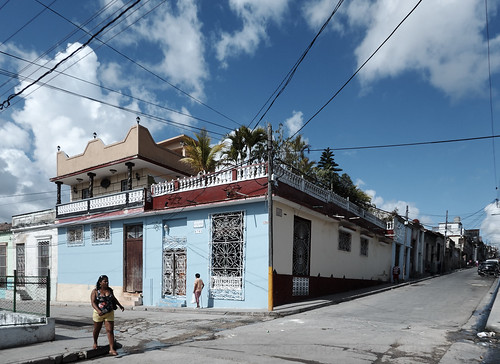
Armando's CP in Matanzas
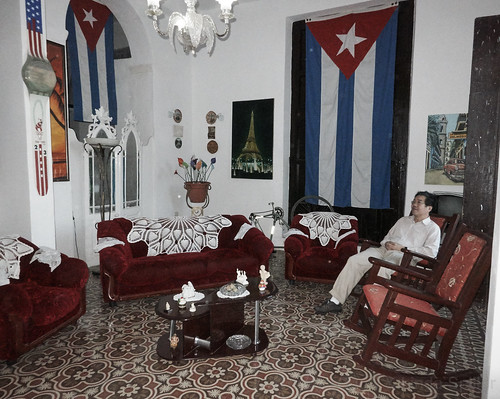
Inside Armando's
After our first breakfast, which we came to know as a big plate of fruit, fresh fruit juice and an egg with bread, we went for a further walk, again exploring the quarter where we stayed, passing a rather-sad zoo (handful of flamingos) and our first commercial market garden – a tiny affair with the stand being the gate. The map indicated there would be a bridge over the Yaumuri to the Hershey train station. Going on this path, we found that it was a pipeline bridge, and the pedestrian part has collapsed years back. This however does not stop the locals who are perfectly happy crossing on the pipeline.
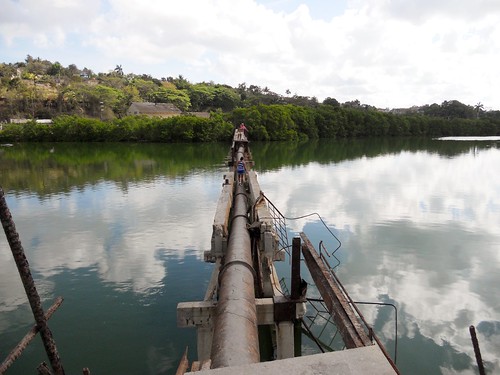 Pipeline bridge
Pipeline bridge
The locals still use this as a bridge. We didn't fancy the challenge
We wanted to take the Hershey train from Matanzas to the Casablanca station in Havana to take in views especially that of the Yumuri valley and the sugar cane fields beyond. There’s only a fleet of two or so Spanish streetcars that reputedly date from 1944 to replace some half-dozen General Electric trains which have long stopped working. One of the Spanish trams has broken down so there’s only one train a day leaving Matanzas and not until late in the afternoon for a 4 hour ride. 8pm arrival was not an option so we decided to take Viazul.
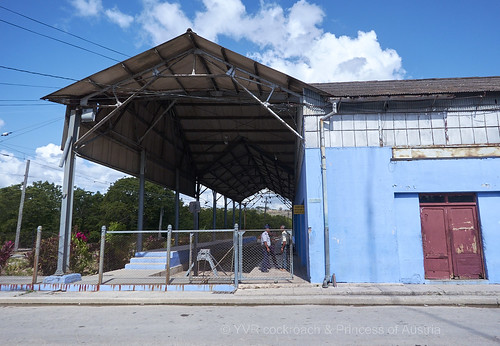
Matanzas end of the Hershey train line
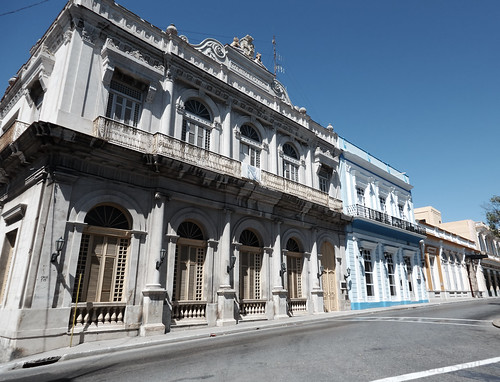
Renovated building in use as the only hotel in Matanzas

Typical street scene in Cuba, in Matanzas
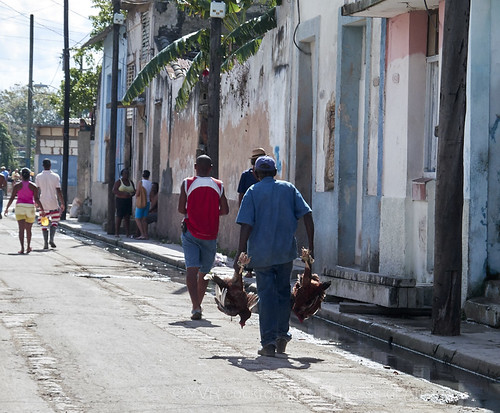
Someone's dinner
Cuban transport hubs are not always located centrally and the Viazul bus terminal was no exception. On the map, it was around a 2 Km walk so we did it. Fortunately we had looked at the photo so we knew what the building was like. We walked to the south of town which is where the long-distance bus terminal is located (transportation hubs such as rail stations, municipal and long-distance bus terminals are reputedly never located next to each other in Cuba and Matanzas is no exception). It looked like a rail station except no passenger railways ran nearby – the train station was 2 Km further down the road. I went up to the Viazul counter and asked the agent for tickets. She made a call and said she wasn’t certain if there was any space and to wait until ½ hr until the bus arrived. In the meantime, three other passengers came and asked for tickets.
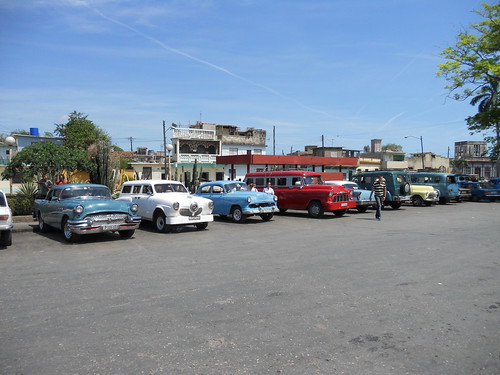
Parking lot at Matanzas bus terminal
When the bus arrived, one of the other passengers got to the counter ahead of me. I told my partner to go out to check the bus to see how empty it was but the agent told her to go back inside quickly. Turned out there were only two seats available on the bus and she told the man in front of me this and that we were the first two so we got the seats. Only 1 or 2 other busses that day and the next one wouldn’t be another for another 2 hours.
On this non-holiday Easter Monday, the bus zipped along virtually-empty double lane which was smooth (or at least smoother than the autopista nacionale west of Havana), just like it was from Matanzas airport to the city. One rest stop before crossing Cuba’s longest bridge and the bus continued towards Havana. All of a sudden, we were in the eastern outskirts of Havana and then into the tunnel under the entrance to Havana harbour and poppng up at the north end of Havana Vieja and you’re at the stop. A whole herd of CP and TP operators greeting you as you disembark. The main terminus is several Km west in an area near the zoo where tourists have really no business going to.
 Viazul bus by YuTong
Viazul bus by YuTong
Bags retrieved, we walked the 1 km+ to our CP which was at the SW end of Havana Vieja. En route, we passed the Liberation Museum, and also Sloppy Joe’s. Havana was all it promised and more. Colourful, interesting and photogenic in its decay.
We arrived at the CP to find no answer at the door. Eventually, an old woman peered out of a window. She motioned to us and lowered a basket. In there was a key to get through the front door which we opened and then returned to her. We climbed up the narrow and dark stairway and knocked on the door and found the casa owner there as he’d just woken up from a nap. The CP operator was a man who had gone to Germany to work as a cook before recently returning to Cuba to be with family. He had bought the apartment in rough condition and fixed it up. We had a nice end room, a bit small but typical for Cuba. Full bath was shared as was a WC added in somehow.
The unit was on the corner. There was of course rooftop access which is where we had a dinner. Just watch for the steel rail used to hoist up furniture. I did forget to mention that the German who referred and recommended us to stay here was gay and so was David. As a sign of the times, David was not afraid of hanging an enormous Pride flag on the balcony.

Casa David on the top floor. About 79 dark, narrow steps up....
The Viazul bus to Havana wasn’t until early in the afternoon so we spent the morning walking around Matanzas. The CP had inquired about the Hershey train for us so we headed to the station to double check. Sure enough, there was no tram until late in the afternoon.

Armando's CP in Matanzas

Inside Armando's
After our first breakfast, which we came to know as a big plate of fruit, fresh fruit juice and an egg with bread, we went for a further walk, again exploring the quarter where we stayed, passing a rather-sad zoo (handful of flamingos) and our first commercial market garden – a tiny affair with the stand being the gate. The map indicated there would be a bridge over the Yaumuri to the Hershey train station. Going on this path, we found that it was a pipeline bridge, and the pedestrian part has collapsed years back. This however does not stop the locals who are perfectly happy crossing on the pipeline.
 Pipeline bridge
Pipeline bridgeThe locals still use this as a bridge. We didn't fancy the challenge
We wanted to take the Hershey train from Matanzas to the Casablanca station in Havana to take in views especially that of the Yumuri valley and the sugar cane fields beyond. There’s only a fleet of two or so Spanish streetcars that reputedly date from 1944 to replace some half-dozen General Electric trains which have long stopped working. One of the Spanish trams has broken down so there’s only one train a day leaving Matanzas and not until late in the afternoon for a 4 hour ride. 8pm arrival was not an option so we decided to take Viazul.

Matanzas end of the Hershey train line

Renovated building in use as the only hotel in Matanzas

Typical street scene in Cuba, in Matanzas

Someone's dinner
Cuban transport hubs are not always located centrally and the Viazul bus terminal was no exception. On the map, it was around a 2 Km walk so we did it. Fortunately we had looked at the photo so we knew what the building was like. We walked to the south of town which is where the long-distance bus terminal is located (transportation hubs such as rail stations, municipal and long-distance bus terminals are reputedly never located next to each other in Cuba and Matanzas is no exception). It looked like a rail station except no passenger railways ran nearby – the train station was 2 Km further down the road. I went up to the Viazul counter and asked the agent for tickets. She made a call and said she wasn’t certain if there was any space and to wait until ½ hr until the bus arrived. In the meantime, three other passengers came and asked for tickets.

Parking lot at Matanzas bus terminal
When the bus arrived, one of the other passengers got to the counter ahead of me. I told my partner to go out to check the bus to see how empty it was but the agent told her to go back inside quickly. Turned out there were only two seats available on the bus and she told the man in front of me this and that we were the first two so we got the seats. Only 1 or 2 other busses that day and the next one wouldn’t be another for another 2 hours.
On this non-holiday Easter Monday, the bus zipped along virtually-empty double lane which was smooth (or at least smoother than the autopista nacionale west of Havana), just like it was from Matanzas airport to the city. One rest stop before crossing Cuba’s longest bridge and the bus continued towards Havana. All of a sudden, we were in the eastern outskirts of Havana and then into the tunnel under the entrance to Havana harbour and poppng up at the north end of Havana Vieja and you’re at the stop. A whole herd of CP and TP operators greeting you as you disembark. The main terminus is several Km west in an area near the zoo where tourists have really no business going to.
 Viazul bus by YuTong
Viazul bus by YuTongBags retrieved, we walked the 1 km+ to our CP which was at the SW end of Havana Vieja. En route, we passed the Liberation Museum, and also Sloppy Joe’s. Havana was all it promised and more. Colourful, interesting and photogenic in its decay.
We arrived at the CP to find no answer at the door. Eventually, an old woman peered out of a window. She motioned to us and lowered a basket. In there was a key to get through the front door which we opened and then returned to her. We climbed up the narrow and dark stairway and knocked on the door and found the casa owner there as he’d just woken up from a nap. The CP operator was a man who had gone to Germany to work as a cook before recently returning to Cuba to be with family. He had bought the apartment in rough condition and fixed it up. We had a nice end room, a bit small but typical for Cuba. Full bath was shared as was a WC added in somehow.
The unit was on the corner. There was of course rooftop access which is where we had a dinner. Just watch for the steel rail used to hoist up furniture. I did forget to mention that the German who referred and recommended us to stay here was gay and so was David. As a sign of the times, David was not afraid of hanging an enormous Pride flag on the balcony.

Casa David on the top floor. About 79 dark, narrow steps up....
#4
FlyerTalk Evangelist
Original Poster
Join Date: Nov 1999
Programs: FB Silver going for Gold
Posts: 21,801
Assortment of travel advice
Viazul
Viazul is the tourist long-distance bus operator, meant for tourists but Cubans with access to hard cash are allowed to use. They have a fleet of relatively-new Chinese-made Yu Tong busses which are nice and modern, with a/c that some reportedly may find very cold. Advanced booking is essential for this service and even more so now given increased tourism.
Beware as some routes such as the one between Santiago – Guantanamo – Baracoa only run once daily. Seated on the bus (where you have to load and unload your bags by yourself in true proletarian fashion), we were on our way on a smooth ride. Traffic in Cuba is as light as is reputed.
Money
Cuba has a dual-currency system though there are imminent plans to unify the two currencies and have it be freely-floating, exchangeable and convertible. Currently, the CUC is the hard currency equivalent though it is artificially pegged against the USD and (as with currencies including the Jordanian Dinar) are readily exchangeable outside the country. Cubans are apparently able to exchange the two currencies freely (paying CUP 25 to buy CUC 1, and getting CUP 24 for CUC 1).
There was no obvious attempt by anyone to buy foreign currency unofficially other than a tout outside one of the Cadecas for locals. Some free museums had staff asking to sell small USD notes as there is a 10% penalty for exchanging USD. No evident hoarding of foreign currency.
Banks helpfully illustrate the difference between the CUC and CUP (CUCs are also marked “convertible”), but not coins. The main difference is that CUC coins are polished and plated and thus shiny silver while CUP coins are not plated hence matte and dull. The difference is that one is worth 24-25x more than the other.
For now, exchange can be done at banks (best rates), followed by Cadecas and finally hotels (worst rates as they’re unregulated). There are touts offering to exchange but you are cautioned against using them as you may get counterfeit notes. ATMs are located at bank branches, even in small towns such as Vinales, though you are advised only to use them during bank hours in case your card gets eaten.
Internet
Access is extremely limited for now with all access through the state telecom entity, ECTESA. One has to physically go to an ECTESA sala de (browsing) and log in with a prepaid card and use the supplied computers (speed appears to be fast). Cubans who have it at home have dial-up service (may be limited to e-mail only). Some of the bigger centers (Santiago de Cuba for one) are reported to offer connection with one’s own device through wi-fi. Hotels are said to offer access through wi-fi for a fee. In my observation of what Cubans use the web (CUC 4.50/hr) for, it appears to be Facebook.
Update: The Cuban government made internet access cheaper and more freely available, though it still remains expensive even with a rate cut of ~50%. You can now bring your own device to ECTESA outlets and wi-fi is available in certain public areas of cities. Internet usage vouchers are available from a wide variety of sources as the government sells them at a lower cost wholesale to those seeking to make a living.
Classic Cars
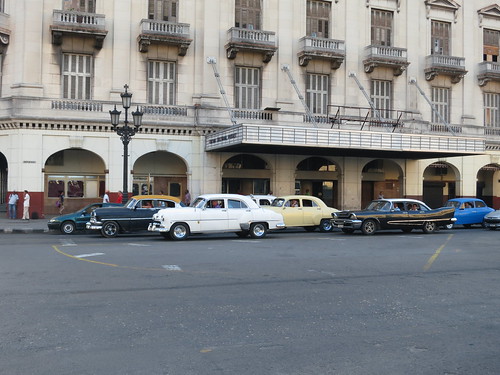
Every day traffic in Havana.....
The classic cars are still around, in amazing numbers with a reputed 60,000 out of the nation’s some 600,000 vehicles. I’ve never seen most of these cars, except on some rare vintage car days, on the street even in the early ‘70s in North America. They’re well-worn though with no new imports of U.S. cars since 1959 and most importantly, no parts. The bodies and chassis are there (former heavily patched for some) but the engines and transmissions are no longer. I rarely heard a Straight-6 or V-8 if at all, and most cars now have small 4 cylinder diesel engines (and apparently transmissions) from Hyundai, Isuzu, Nissan and others, with luckier ones having Daimler-Benz engines. They do the job as these are not used not just as personal cars but as taxis. Assorted Citroens, Austins and Mercedes in addition to the American staples, including some recently-dead brands (Pontiac, Oldsmobile, Plymouth) and long-dead ones (De Soto, Nash, Studebaker, Edsel, Willys). There was even a Model A Ford from 1914. No Corvettes and Thunderbirds noticed.
Photo album here
An Iconic thing to do
In Havana, the drivers of convertibles make a roaring trade driving visitors around for an hour. CUC 30/hr seems to be the going rate though it appears you can get one for CUC 25. There are pedicabs and horse carriages offering the same but they don’t have the cachet or draw of a grand old convertible. In other places, drivers of the old cars are quite competitive in rates against other vehicles (newer ones or Ladas). We arranged a transfer between Gibara and Holguin in a 1952 Chrysler Saratoga for CUC 20 and in a ’55 Chevy Bel-Air from Holguin to the airport for CUC 15.

Convertibles waiting to take you for the classic Havana tour
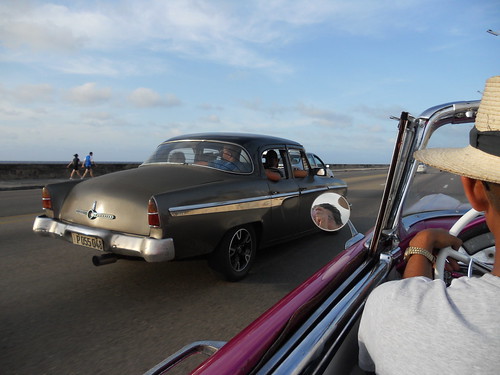 Studebaker???
Studebaker???
When was the last time you got passed by one?
Like the private restaurant, private taxis (Taxi Particulars) are permitted in Cuba and all you apparently need is a sign (they sell them in fuel stations). Not official, they fill in a need in rural areas where bus service is next to non-existent.
The rest of Havana
It’s a big sprawling city but there isn’t too much to see outside Vieja. Vedado, starting just west of the Prado where the city was once walled, has the old Barrio Chino – supposedly once the largest in the Americas and Partagas factory (still closed for renovations though the shop is open and there is one cigar maker there). A bit further out is the storied Hotel Nacionale once frequented by gangsters, celebrities and politicians. The U.S. de facto embassy (update: Now the embassy again) is further out some ways on the Malecon and is a site of cold war antics. Not really much to see and do in these far out suburbs unless one has work or family there other than for the city cemetery.
One stop on the convertible circuit is the revolutionary monument where adjacent government buildings have steel rail murals of Che Guevara and Camilo Cienfuegos and their quotes (“towards a perpetual revolution” for Che and “you’re doing well, Fidel” for Camilo. There are similar works in Santiago.
Public transportation in Cuba and even Havana is limited. Busses are said to run infrequently and irregularly. Many locals who can afford it take communal taxis (usually hardtop U.S. classic cars) or trucks converted into minibuses.
Water
Cuban tap water is said to be non-potable and I have not ventured to disprove it. Havana among other places may not have running water to older buildings as you see trucks with huge tanks of potable water and every place we stayed in had cisterns. We saw street vendors pushing tank carts through Holguin to sell water. I used tap water to brush my teeth and rinse, but not swallow, with no ill effects. Ciego Montero, the national bottler (also produces Cola in sugar and diet form (latter is hard to find)) sells water in various sizes though chilled water in anything but the small 500 ml bottles may be hard to find. Water was seemingly unavailable in any stores in Holguin and Gibera, though both had ample supplies of soft drinks and fruit juices from Chile and Spain and of course rum in all shapes and sizes. Bottles are also sold in 1.5l and 5l sizes though the latter can be more difficult to find. Prices for the former seem to range from CUC 0.70 to CUC 1 (avoid tourist shops) while the latter when available is CUC 1.90
Forced Ride-giving: Apparently a legend
It was said that in the past, Cuban police would force cars with empty spaces to give rides to those seeking transportation (public transport outside cities still remains vastly inadequate). Apparently, this is a legend and only ever applied to government vehicles (currently identified with a B prefix on the number plate), and it is still currently true. Inspectors in yellow are found at major ride points on the highway and will flag down B-registered vehicles. Private (P) and tourist (T) are exempt.
Birds and wildlife
Bird-watching is certainly an attraction in Cuba as there is a significant amount of habitat available, not just the some 20% of the country set aside for parks and reserves. Cuba has the world-smallest known bird (bee hummingbird), frog and bat (moth bat) species worldwide. There are gulls (small black-faced ones) but along the seashore as well as inland, turkey vultures are pretty much ubiquitous. The Cuban Trogon fortunately is very common and sports the national colours of pastel blue, red and white. Zapata reserve is said to be one of the best areas The Royal and Ivory-billed woodpeckers are believed to exist in the eastern pine forests.
Tours and Tourism
The whole tourism industry in Cuba seems to be divided between Transtur and Gaviota which is a branch of the Cuban military. Both have the exclusive fleet of new tour busses in Cuba with Gaviota also having hotels and other lodging of various grades. Cubanacan also operates
The military officers in Cuba are well educated, as is the general populace, and the military levers this by having its enterprises staffed by technocrats.
Control Points
Cuba’s main roads and highways have control points where one has to slow down and be subject to being checked and questioned by police. T-registered vehicles seem to be left alone, as are most others. There are only a handful of officers manning these. The only time we had to pull over was in Guantanamo with roads leading to the U.S. base but we were just waved on without any questions.
Food
Cuba, for various reasons, tries to be self-sufficient in food so imports, especially of processed packaged and frozen foods, appears limited and thus so it availability. For these reasons, you are likely to get a true meal with almost all ingredients sourced locally. Rice, black and red beans, mandioca/yucca (less popular in the east, it would seem), potatoes (waxy and not dry and starchy like potatoes in North America), sweet potatoes are starch staples. Taro seems to be popular in spots. Certain locations, such as around Santiago, have this massive potato-related tuber not found anywhere else. One class of items the U.S. has always exported to Cuba despite the embargo is food, as the meat industry has a powerful lobby.
As CPs, you will get fruit juice and this is likely to be fresh as packaged juices are expensive (even by 1st world standards). The juice, and cut fruit at least in April are pineapple, guava, and catualfa mangos.
Bananas are not the ubiquitous Cavendish found everywhere else and have a different, moister texture and some even are pleasantly tart and acidic like an apple. There are quite a few regional fruits that are available only regionally. Everything is mostly picked ripe and served fresh.
Tomatoes, field cucumber and white cabbage are main salad staples. Not much hope of lettuce except at an excellent paladar.
Cubans appear to like their plantains green and starchy and not sweet (maduros). Plantains are even boiled to resemble potatoes. Cavendish bananas, the major varietal grown worldwide by the likes of Chiquita and Dole appear to be unknown in Cuba, which has its own varieties – of domestic or foreign origin - which certainly have a different taste and texture, perhaps due to being picked ripe. Hopefully Cuba will be spared the next banana blight which will deprive most of the advanced economies of the fruit.
Drinks
The Holy Trinity is of course mojitos, daiquiris and Cuba Libres (a.k.a rum and cola). Sloppy Joe’s has a signature namesake drink consisting of brandy, Cointreau, pineapple juice and.<> We didn’t seen it anywhere else in Cuba but it is delicious. Mojitos in Havana are a lot less sugary and sweet then elsewhere in Cuba and the world, also adequately minty without a huge usage of mint. Maybe it is local conditions but the mint doesn’t require muddling as Mojitos in North America often do. Outside Havana, sugar is added so the drink does not have to be sweet if you don’t stir and don’t drink the bottom. Drinks are strong except reputedly at Bodaguita de Medio in Havana, which is why Hemingway reportedly avoided the place and went to Dos Hermanos instead, as we did. Daiquiris are the specialty at La Floridita which is too busy and too expensive, but good for the experience (scrawny dancing mutton dressed as lamb visually). I saw roadside Screwdrivers (with fresh-squeezed orange juice machine) sold roadside on Obispo – the Havana shopping drag - for CUC 1. Highball prices seem to vary from CUC 2 (at a locals bar in Vinales and also surprisingly at the Asturian cultural society’s Las Terrazas on the Prado) to 4 and up at the storied bars.
 La Floridita
La Floridita
Already infested with tourists
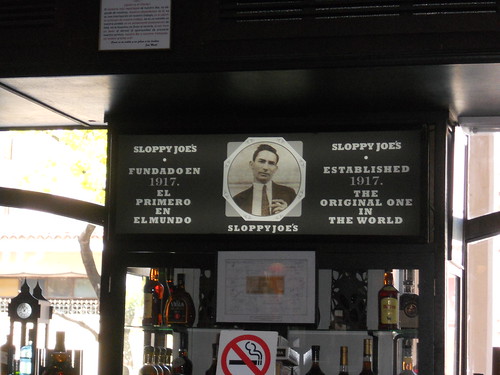 The original Sloppy Joe's
The original Sloppy Joe's
A/C is a welcome addition
We found that drinking strong rum drinks (made with Havana Club) did not give us any hangovers. Some travellers we met said Cubans they met say they drink over a bottle or rum in an evening with no ill effects. The average lifespan is high which seems to bear out that alcohol doesn’t kill you as easily here. Perhaps this is due to the purity of Cuban rum’s ingredient. The impurities in the fermented sugary/starchy liquid which is also what gives flavour, phenols, are what is said to give you a hangover. Havana Club claims to make their rum out of straight cane sugar which should chemically turn into pure ethanol. Better than the brand previously located in Cuba at any rate which uses molasses.
Local beers include Bucanero (surprisingly very good – better than most mass-market beers I’ve tasted) and comes in a fuerte (strong – 5.4% and flavourful). Cristal and Hatuey (Santiago de Cuba) are another other brands which are not so good.
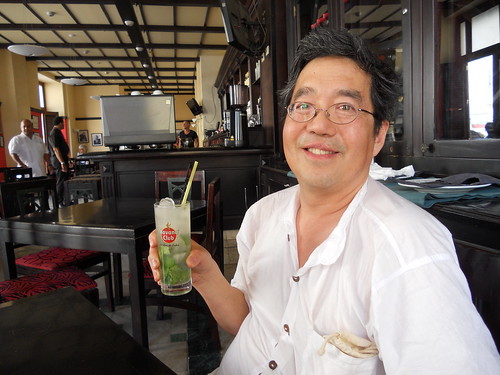 Mojito
Mojito
Enjoying a mojito at Dos Hermanos, Havana Vieja
Rum
Lots of it and cheap. A 1l bottle of aged (to some degree in white oak) white Havana Club is CUC 5.20 everywhere with the 0.7l selling for CUC 3.85. Very smooth, almost indiscernible in a mix, and very drinkable on its own unlike those of a formerly-Cuban brand. Dark Havana Club costs more, as do the various specialised aged rums.
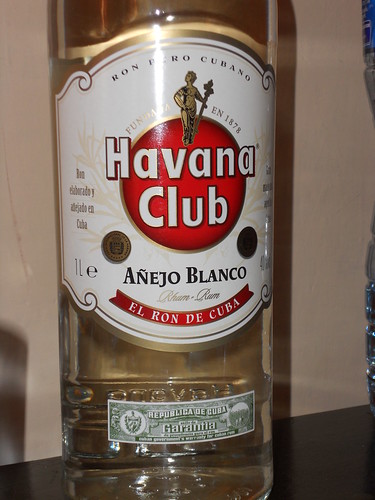 DSCN9907
DSCN9907
Basic and cheapest Havana Club. Probably the cleanest and purest spirit in the world. You can drink a lot and not get a hangover the next day.
Cigars
Again sold everywhere and cheap. Prices are identical in approved stores but apparently much more at roadside attractions where the casual tourist is unloaded. Lucky Strike appears to be a cigarette of choice. Smoking doesn’t appear to be common even compared to tobacco-friendly parts of North America but maybe it is hidden. The specialist government shops are the places to go to with a couple in Havana outstanding with sales staff who know what they are selling (not all do). The shops located in the Hotel Nacionale, on Obispo next to La Floridita and at the currently-closed Partagas factory building behind the Capitolio are said to be the best.
As for bringing home cigars, only buy at a licensed, legal establishment as Cuban customs limits exports of cigars over a certain limits without a receipt. The most-common proposition I received from jineteros was to sell me a cheap (probably bootlegged) cigar.
Shopping
Not much to buy with the only things being the trifecta of rum, cigars and coffee. There are some souvenirs but they all seem to be the same though I doubt they’re imported from China (for now). T-shirts, revolutionary hats, license plates, wooden carvings. West of Trinidad is known for hand-sewn lace work (Valle de Ingenieros) while the main highway between Camaguey and Las Tunas has a town that makes hats out of the bark of a local tree rather than straw (or sugar cane).
After visiting many countries, I would say that abandoned (ill-concieved?) structures are no more common in Cuba than they are in, say, Italy, France, Argentina, Peru and Malaysia among other places. Decay just happens a lot faster in the tropics.
Poverty and well-being
The local populace are poor but don’t appear to be poorer than a plethora of countries including Egypt, Belize, Paraguay, Myanmar, Sri Lanka, Indonesia and Thailand, and certainly don’t appear to be malnourished or diseased. You certainly don’t have children trying to sell you or asking for something.
Life may be hard-scrabble in the rural areas here though so people try to earn CUCs anyway they can.
Traffic
Fortunately it’s very light for now. Cuba cannot really afford much more traffic as there will be no where to park, drive or get anywhere. The double-lane roads are a dream to drive on, as long as you avoid the rough patches. Road in the east can get very rough especially in Guantanamo province.
What to See
Architecture is the main focus in Cuban cities, in addition to music. The bulk of the attractive colonial core is limited Havana Vieja though Trinidad is one of the best cities for this. The other cities have smaller cores with some having only a handful of significant buildings. Cienfuegos is said to have a French influence but the handful of Art Noveau/Deco buildings seem more interesting.
Nature has a big role. Due to a relative lack of land clearing (for housing, intensive agriculture (less land cultivated now than in the past), etc.), there’s quite a lot of habitat available for birds, reptiles, plant species, quite a few of which are endemic to Cuba.
Viazul is the tourist long-distance bus operator, meant for tourists but Cubans with access to hard cash are allowed to use. They have a fleet of relatively-new Chinese-made Yu Tong busses which are nice and modern, with a/c that some reportedly may find very cold. Advanced booking is essential for this service and even more so now given increased tourism.
Beware as some routes such as the one between Santiago – Guantanamo – Baracoa only run once daily. Seated on the bus (where you have to load and unload your bags by yourself in true proletarian fashion), we were on our way on a smooth ride. Traffic in Cuba is as light as is reputed.
Money
Cuba has a dual-currency system though there are imminent plans to unify the two currencies and have it be freely-floating, exchangeable and convertible. Currently, the CUC is the hard currency equivalent though it is artificially pegged against the USD and (as with currencies including the Jordanian Dinar) are readily exchangeable outside the country. Cubans are apparently able to exchange the two currencies freely (paying CUP 25 to buy CUC 1, and getting CUP 24 for CUC 1).
There was no obvious attempt by anyone to buy foreign currency unofficially other than a tout outside one of the Cadecas for locals. Some free museums had staff asking to sell small USD notes as there is a 10% penalty for exchanging USD. No evident hoarding of foreign currency.
Banks helpfully illustrate the difference between the CUC and CUP (CUCs are also marked “convertible”), but not coins. The main difference is that CUC coins are polished and plated and thus shiny silver while CUP coins are not plated hence matte and dull. The difference is that one is worth 24-25x more than the other.
For now, exchange can be done at banks (best rates), followed by Cadecas and finally hotels (worst rates as they’re unregulated). There are touts offering to exchange but you are cautioned against using them as you may get counterfeit notes. ATMs are located at bank branches, even in small towns such as Vinales, though you are advised only to use them during bank hours in case your card gets eaten.
Internet
Access is extremely limited for now with all access through the state telecom entity, ECTESA. One has to physically go to an ECTESA sala de (browsing) and log in with a prepaid card and use the supplied computers (speed appears to be fast). Cubans who have it at home have dial-up service (may be limited to e-mail only). Some of the bigger centers (Santiago de Cuba for one) are reported to offer connection with one’s own device through wi-fi. Hotels are said to offer access through wi-fi for a fee. In my observation of what Cubans use the web (CUC 4.50/hr) for, it appears to be Facebook.
Update: The Cuban government made internet access cheaper and more freely available, though it still remains expensive even with a rate cut of ~50%. You can now bring your own device to ECTESA outlets and wi-fi is available in certain public areas of cities. Internet usage vouchers are available from a wide variety of sources as the government sells them at a lower cost wholesale to those seeking to make a living.
Classic Cars

Every day traffic in Havana.....
The classic cars are still around, in amazing numbers with a reputed 60,000 out of the nation’s some 600,000 vehicles. I’ve never seen most of these cars, except on some rare vintage car days, on the street even in the early ‘70s in North America. They’re well-worn though with no new imports of U.S. cars since 1959 and most importantly, no parts. The bodies and chassis are there (former heavily patched for some) but the engines and transmissions are no longer. I rarely heard a Straight-6 or V-8 if at all, and most cars now have small 4 cylinder diesel engines (and apparently transmissions) from Hyundai, Isuzu, Nissan and others, with luckier ones having Daimler-Benz engines. They do the job as these are not used not just as personal cars but as taxis. Assorted Citroens, Austins and Mercedes in addition to the American staples, including some recently-dead brands (Pontiac, Oldsmobile, Plymouth) and long-dead ones (De Soto, Nash, Studebaker, Edsel, Willys). There was even a Model A Ford from 1914. No Corvettes and Thunderbirds noticed.
Photo album here
An Iconic thing to do
In Havana, the drivers of convertibles make a roaring trade driving visitors around for an hour. CUC 30/hr seems to be the going rate though it appears you can get one for CUC 25. There are pedicabs and horse carriages offering the same but they don’t have the cachet or draw of a grand old convertible. In other places, drivers of the old cars are quite competitive in rates against other vehicles (newer ones or Ladas). We arranged a transfer between Gibara and Holguin in a 1952 Chrysler Saratoga for CUC 20 and in a ’55 Chevy Bel-Air from Holguin to the airport for CUC 15.

Convertibles waiting to take you for the classic Havana tour
 Studebaker???
Studebaker??? When was the last time you got passed by one?
Like the private restaurant, private taxis (Taxi Particulars) are permitted in Cuba and all you apparently need is a sign (they sell them in fuel stations). Not official, they fill in a need in rural areas where bus service is next to non-existent.
The rest of Havana
It’s a big sprawling city but there isn’t too much to see outside Vieja. Vedado, starting just west of the Prado where the city was once walled, has the old Barrio Chino – supposedly once the largest in the Americas and Partagas factory (still closed for renovations though the shop is open and there is one cigar maker there). A bit further out is the storied Hotel Nacionale once frequented by gangsters, celebrities and politicians. The U.S. de facto embassy (update: Now the embassy again) is further out some ways on the Malecon and is a site of cold war antics. Not really much to see and do in these far out suburbs unless one has work or family there other than for the city cemetery.
One stop on the convertible circuit is the revolutionary monument where adjacent government buildings have steel rail murals of Che Guevara and Camilo Cienfuegos and their quotes (“towards a perpetual revolution” for Che and “you’re doing well, Fidel” for Camilo. There are similar works in Santiago.
Public transportation in Cuba and even Havana is limited. Busses are said to run infrequently and irregularly. Many locals who can afford it take communal taxis (usually hardtop U.S. classic cars) or trucks converted into minibuses.
Water
Cuban tap water is said to be non-potable and I have not ventured to disprove it. Havana among other places may not have running water to older buildings as you see trucks with huge tanks of potable water and every place we stayed in had cisterns. We saw street vendors pushing tank carts through Holguin to sell water. I used tap water to brush my teeth and rinse, but not swallow, with no ill effects. Ciego Montero, the national bottler (also produces Cola in sugar and diet form (latter is hard to find)) sells water in various sizes though chilled water in anything but the small 500 ml bottles may be hard to find. Water was seemingly unavailable in any stores in Holguin and Gibera, though both had ample supplies of soft drinks and fruit juices from Chile and Spain and of course rum in all shapes and sizes. Bottles are also sold in 1.5l and 5l sizes though the latter can be more difficult to find. Prices for the former seem to range from CUC 0.70 to CUC 1 (avoid tourist shops) while the latter when available is CUC 1.90
Forced Ride-giving: Apparently a legend
It was said that in the past, Cuban police would force cars with empty spaces to give rides to those seeking transportation (public transport outside cities still remains vastly inadequate). Apparently, this is a legend and only ever applied to government vehicles (currently identified with a B prefix on the number plate), and it is still currently true. Inspectors in yellow are found at major ride points on the highway and will flag down B-registered vehicles. Private (P) and tourist (T) are exempt.
Birds and wildlife
Bird-watching is certainly an attraction in Cuba as there is a significant amount of habitat available, not just the some 20% of the country set aside for parks and reserves. Cuba has the world-smallest known bird (bee hummingbird), frog and bat (moth bat) species worldwide. There are gulls (small black-faced ones) but along the seashore as well as inland, turkey vultures are pretty much ubiquitous. The Cuban Trogon fortunately is very common and sports the national colours of pastel blue, red and white. Zapata reserve is said to be one of the best areas The Royal and Ivory-billed woodpeckers are believed to exist in the eastern pine forests.
Tours and Tourism
The whole tourism industry in Cuba seems to be divided between Transtur and Gaviota which is a branch of the Cuban military. Both have the exclusive fleet of new tour busses in Cuba with Gaviota also having hotels and other lodging of various grades. Cubanacan also operates
The military officers in Cuba are well educated, as is the general populace, and the military levers this by having its enterprises staffed by technocrats.
Control Points
Cuba’s main roads and highways have control points where one has to slow down and be subject to being checked and questioned by police. T-registered vehicles seem to be left alone, as are most others. There are only a handful of officers manning these. The only time we had to pull over was in Guantanamo with roads leading to the U.S. base but we were just waved on without any questions.
Food
Cuba, for various reasons, tries to be self-sufficient in food so imports, especially of processed packaged and frozen foods, appears limited and thus so it availability. For these reasons, you are likely to get a true meal with almost all ingredients sourced locally. Rice, black and red beans, mandioca/yucca (less popular in the east, it would seem), potatoes (waxy and not dry and starchy like potatoes in North America), sweet potatoes are starch staples. Taro seems to be popular in spots. Certain locations, such as around Santiago, have this massive potato-related tuber not found anywhere else. One class of items the U.S. has always exported to Cuba despite the embargo is food, as the meat industry has a powerful lobby.
As CPs, you will get fruit juice and this is likely to be fresh as packaged juices are expensive (even by 1st world standards). The juice, and cut fruit at least in April are pineapple, guava, and catualfa mangos.
Bananas are not the ubiquitous Cavendish found everywhere else and have a different, moister texture and some even are pleasantly tart and acidic like an apple. There are quite a few regional fruits that are available only regionally. Everything is mostly picked ripe and served fresh.
Tomatoes, field cucumber and white cabbage are main salad staples. Not much hope of lettuce except at an excellent paladar.
Cubans appear to like their plantains green and starchy and not sweet (maduros). Plantains are even boiled to resemble potatoes. Cavendish bananas, the major varietal grown worldwide by the likes of Chiquita and Dole appear to be unknown in Cuba, which has its own varieties – of domestic or foreign origin - which certainly have a different taste and texture, perhaps due to being picked ripe. Hopefully Cuba will be spared the next banana blight which will deprive most of the advanced economies of the fruit.
Drinks
The Holy Trinity is of course mojitos, daiquiris and Cuba Libres (a.k.a rum and cola). Sloppy Joe’s has a signature namesake drink consisting of brandy, Cointreau, pineapple juice and.<> We didn’t seen it anywhere else in Cuba but it is delicious. Mojitos in Havana are a lot less sugary and sweet then elsewhere in Cuba and the world, also adequately minty without a huge usage of mint. Maybe it is local conditions but the mint doesn’t require muddling as Mojitos in North America often do. Outside Havana, sugar is added so the drink does not have to be sweet if you don’t stir and don’t drink the bottom. Drinks are strong except reputedly at Bodaguita de Medio in Havana, which is why Hemingway reportedly avoided the place and went to Dos Hermanos instead, as we did. Daiquiris are the specialty at La Floridita which is too busy and too expensive, but good for the experience (scrawny dancing mutton dressed as lamb visually). I saw roadside Screwdrivers (with fresh-squeezed orange juice machine) sold roadside on Obispo – the Havana shopping drag - for CUC 1. Highball prices seem to vary from CUC 2 (at a locals bar in Vinales and also surprisingly at the Asturian cultural society’s Las Terrazas on the Prado) to 4 and up at the storied bars.
 La Floridita
La FloriditaAlready infested with tourists
 The original Sloppy Joe's
The original Sloppy Joe'sA/C is a welcome addition
We found that drinking strong rum drinks (made with Havana Club) did not give us any hangovers. Some travellers we met said Cubans they met say they drink over a bottle or rum in an evening with no ill effects. The average lifespan is high which seems to bear out that alcohol doesn’t kill you as easily here. Perhaps this is due to the purity of Cuban rum’s ingredient. The impurities in the fermented sugary/starchy liquid which is also what gives flavour, phenols, are what is said to give you a hangover. Havana Club claims to make their rum out of straight cane sugar which should chemically turn into pure ethanol. Better than the brand previously located in Cuba at any rate which uses molasses.
Local beers include Bucanero (surprisingly very good – better than most mass-market beers I’ve tasted) and comes in a fuerte (strong – 5.4% and flavourful). Cristal and Hatuey (Santiago de Cuba) are another other brands which are not so good.
 Mojito
Mojito Enjoying a mojito at Dos Hermanos, Havana Vieja
Rum
Lots of it and cheap. A 1l bottle of aged (to some degree in white oak) white Havana Club is CUC 5.20 everywhere with the 0.7l selling for CUC 3.85. Very smooth, almost indiscernible in a mix, and very drinkable on its own unlike those of a formerly-Cuban brand. Dark Havana Club costs more, as do the various specialised aged rums.
 DSCN9907
DSCN9907 Basic and cheapest Havana Club. Probably the cleanest and purest spirit in the world. You can drink a lot and not get a hangover the next day.
Cigars
Again sold everywhere and cheap. Prices are identical in approved stores but apparently much more at roadside attractions where the casual tourist is unloaded. Lucky Strike appears to be a cigarette of choice. Smoking doesn’t appear to be common even compared to tobacco-friendly parts of North America but maybe it is hidden. The specialist government shops are the places to go to with a couple in Havana outstanding with sales staff who know what they are selling (not all do). The shops located in the Hotel Nacionale, on Obispo next to La Floridita and at the currently-closed Partagas factory building behind the Capitolio are said to be the best.
As for bringing home cigars, only buy at a licensed, legal establishment as Cuban customs limits exports of cigars over a certain limits without a receipt. The most-common proposition I received from jineteros was to sell me a cheap (probably bootlegged) cigar.
Shopping
Not much to buy with the only things being the trifecta of rum, cigars and coffee. There are some souvenirs but they all seem to be the same though I doubt they’re imported from China (for now). T-shirts, revolutionary hats, license plates, wooden carvings. West of Trinidad is known for hand-sewn lace work (Valle de Ingenieros) while the main highway between Camaguey and Las Tunas has a town that makes hats out of the bark of a local tree rather than straw (or sugar cane).
After visiting many countries, I would say that abandoned (ill-concieved?) structures are no more common in Cuba than they are in, say, Italy, France, Argentina, Peru and Malaysia among other places. Decay just happens a lot faster in the tropics.
Poverty and well-being
The local populace are poor but don’t appear to be poorer than a plethora of countries including Egypt, Belize, Paraguay, Myanmar, Sri Lanka, Indonesia and Thailand, and certainly don’t appear to be malnourished or diseased. You certainly don’t have children trying to sell you or asking for something.
Life may be hard-scrabble in the rural areas here though so people try to earn CUCs anyway they can.
Traffic
Fortunately it’s very light for now. Cuba cannot really afford much more traffic as there will be no where to park, drive or get anywhere. The double-lane roads are a dream to drive on, as long as you avoid the rough patches. Road in the east can get very rough especially in Guantanamo province.
What to See
Architecture is the main focus in Cuban cities, in addition to music. The bulk of the attractive colonial core is limited Havana Vieja though Trinidad is one of the best cities for this. The other cities have smaller cores with some having only a handful of significant buildings. Cienfuegos is said to have a French influence but the handful of Art Noveau/Deco buildings seem more interesting.
Nature has a big role. Due to a relative lack of land clearing (for housing, intensive agriculture (less land cultivated now than in the past), etc.), there’s quite a lot of habitat available for birds, reptiles, plant species, quite a few of which are endemic to Cuba.
Last edited by YVR Cockroach; Jun 30, 2016 at 7:34 pm Reason: Photo addition
#6
FlyerTalk Evangelist
Original Poster
Join Date: Nov 1999
Programs: FB Silver going for Gold
Posts: 21,801
Continuing on. Just posting pictures with some comments
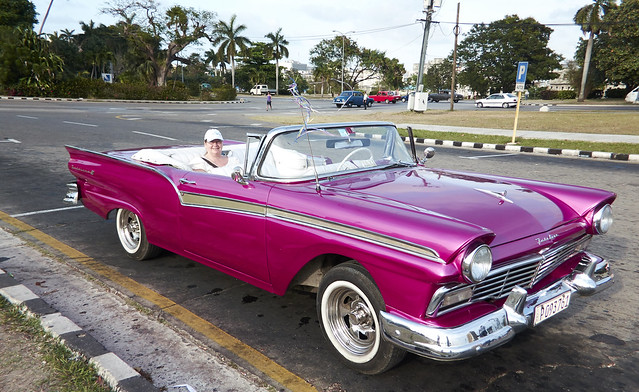
Mandatory convertible ride. We got a '57 Ford Fairlane with a Hyundai engine
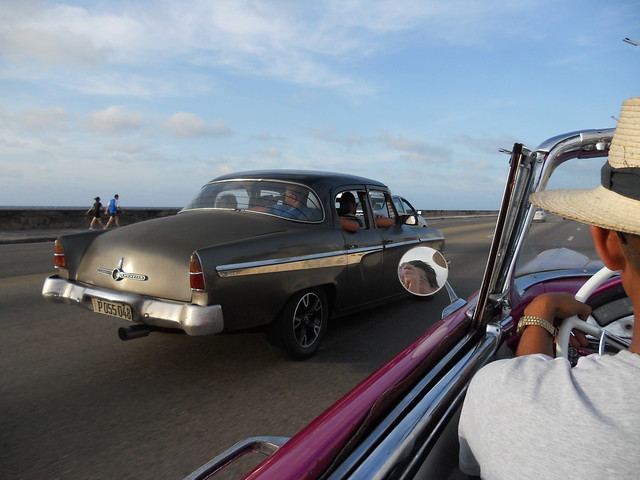 Studebaker???
Studebaker???
When was the last time you got passed by one?
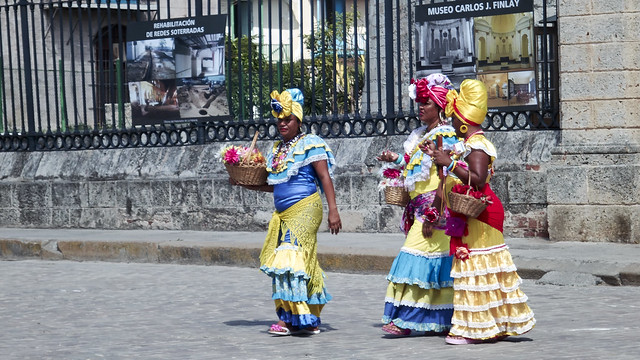
Professional photo models at the Cathedral Plaza.
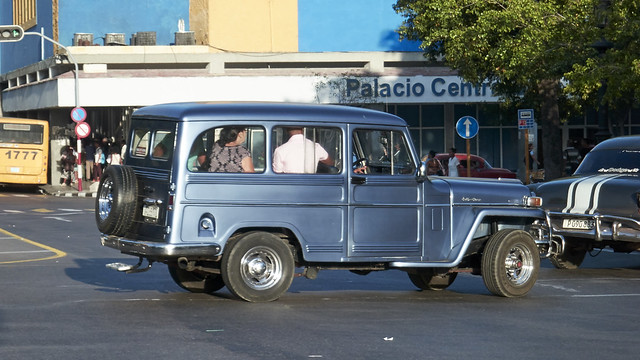
4 door Willys Jeep. Reportedly very popular in the far east for use as taxi particulares as the highway isn't paved.
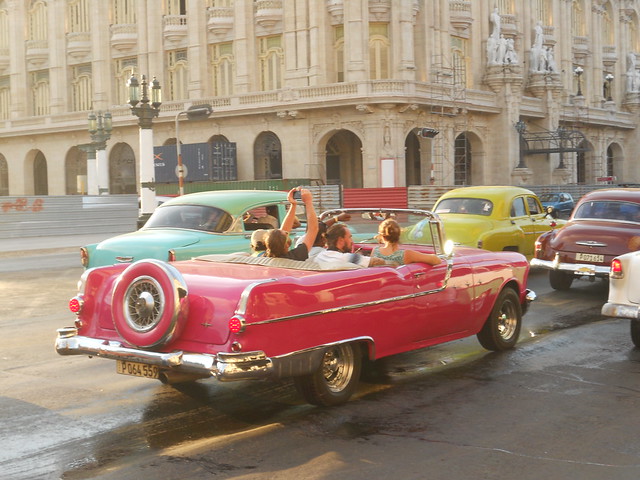
Tourist starting their mandatory convertible ride passing the front of the opera house. The car is not a Lincoln (which had fake spare wheel bumps in the trunk lid into the '80s if not later). The tire on the back bumper is called a Continental kit and was apparently a dealer-installed option back in the day.
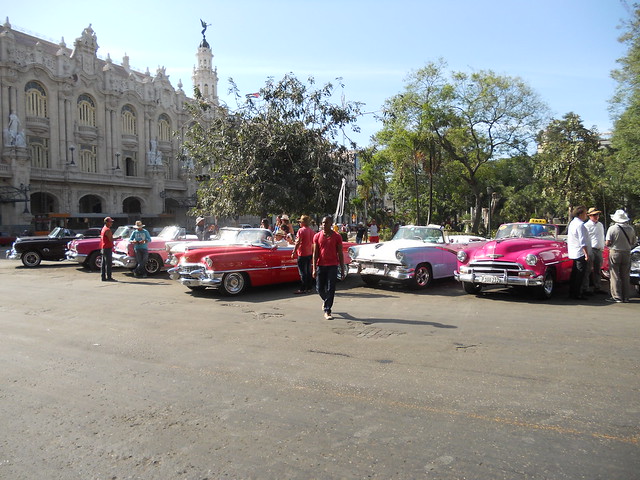
The convertible bull pen. Take your pick of ride.
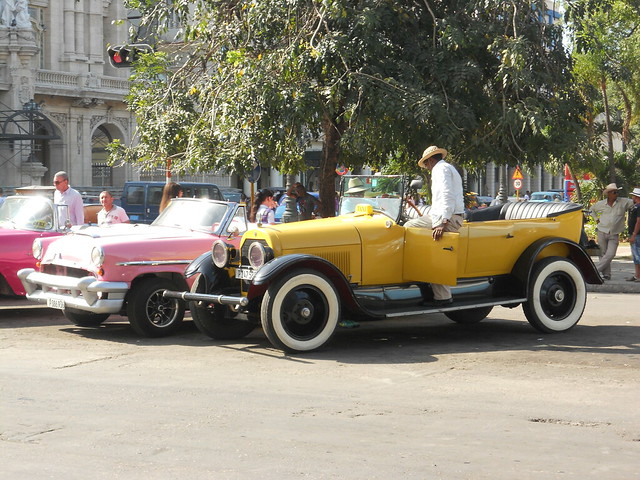
Even on this near centennial Model A Ford(?)
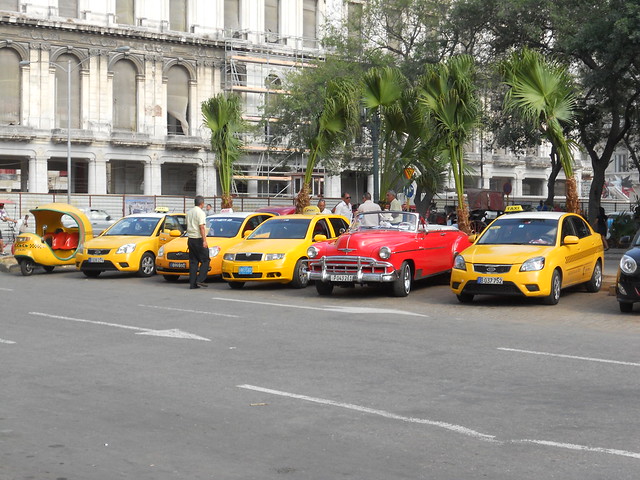
Most of these guys don't stand a chance for the Mandatory Convertible Ride.
 Edificio Bacardi
Edificio Bacardi
Rumours of a bar inside
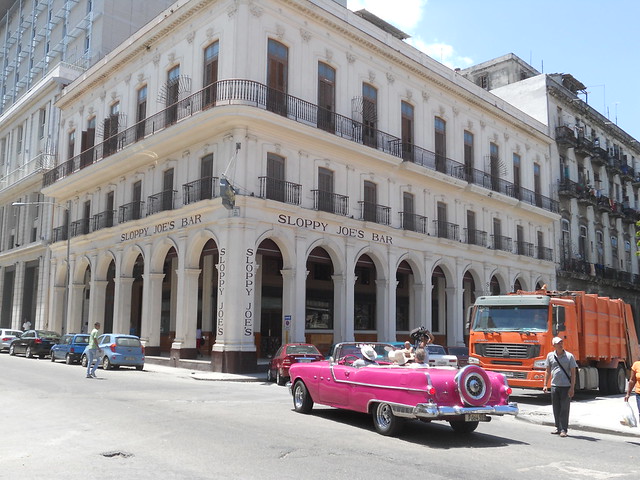 Outside Sloppy Joe's
Outside Sloppy Joe's
The one and only original. Stop in for the namesake signature drink. I had at least 2, maybe 3. The building and bar was reported to be a ruin but has been nicely restored by Habaguanex, with a/c and all.
 Che Guevara
Che Guevara
Revolutionary plaza and the associated governmental buildings.
 The famed Havana Hilton
The famed Havana Hilton
Apologies for some of the photos. They seem to be normal brightness/properly exposed/adjusted when I view them but too bright once loaded on Flickr.

Mandatory convertible ride. We got a '57 Ford Fairlane with a Hyundai engine
 Studebaker???
Studebaker???When was the last time you got passed by one?

Professional photo models at the Cathedral Plaza.

4 door Willys Jeep. Reportedly very popular in the far east for use as taxi particulares as the highway isn't paved.

Tourist starting their mandatory convertible ride passing the front of the opera house. The car is not a Lincoln (which had fake spare wheel bumps in the trunk lid into the '80s if not later). The tire on the back bumper is called a Continental kit and was apparently a dealer-installed option back in the day.

The convertible bull pen. Take your pick of ride.

Even on this near centennial Model A Ford(?)

Most of these guys don't stand a chance for the Mandatory Convertible Ride.
 Edificio Bacardi
Edificio BacardiRumours of a bar inside
 Outside Sloppy Joe's
Outside Sloppy Joe'sThe one and only original. Stop in for the namesake signature drink. I had at least 2, maybe 3. The building and bar was reported to be a ruin but has been nicely restored by Habaguanex, with a/c and all.
 Che Guevara
Che GuevaraRevolutionary plaza and the associated governmental buildings.
 The famed Havana Hilton
The famed Havana HiltonApologies for some of the photos. They seem to be normal brightness/properly exposed/adjusted when I view them but too bright once loaded on Flickr.
Last edited by YVR Cockroach; Jan 27, 2017 at 5:54 pm Reason: Adding photos, check back later
#7
FlyerTalk Evangelist
Original Poster
Join Date: Nov 1999
Programs: FB Silver going for Gold
Posts: 21,801
Vinales
After 3 nights in Havana, we were met by our driver-guide and headed west to Vinales.
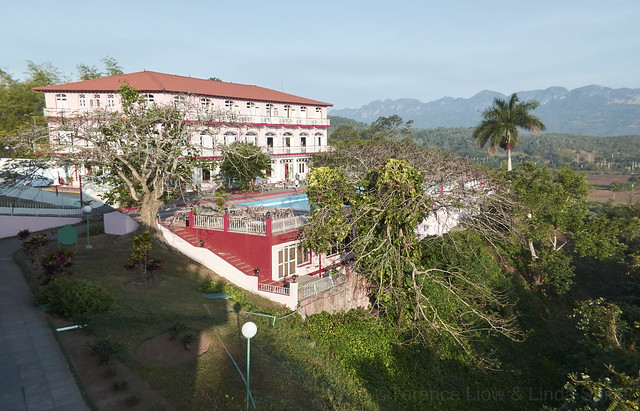
This hotel is the place to stay in Vinales (though a little bit isolated). Nearly impossible to get into as it is booked out by tour groups

Dawn in Vinales. It's nice to walk around these limestone hills.
 Farm gate store
Farm gate store
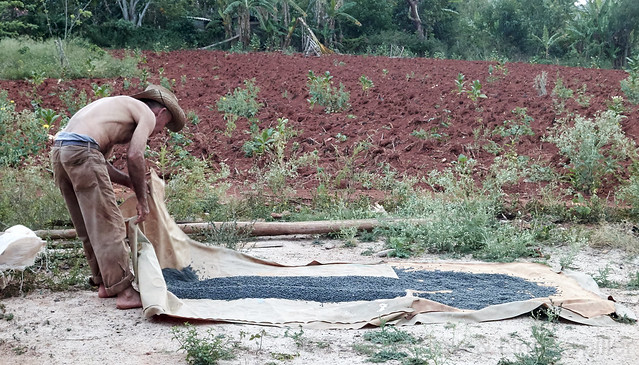 Beans being dried by the campesino. The family has a nice CP with 2 rooms.
Beans being dried by the campesino. The family has a nice CP with 2 rooms.
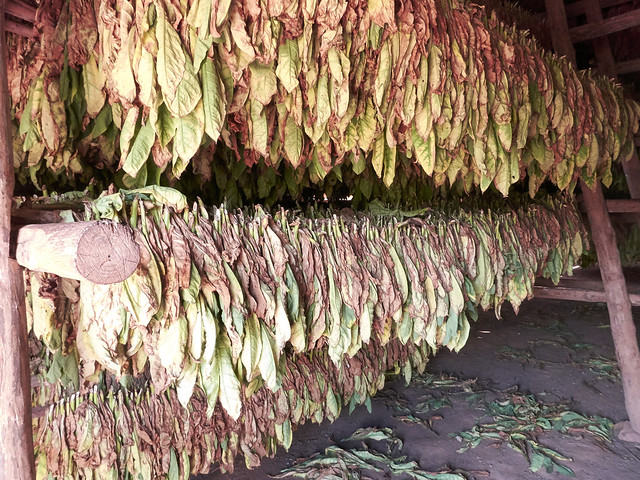 Dried tobacco
Dried tobacco
The best stuff is said to be grown here
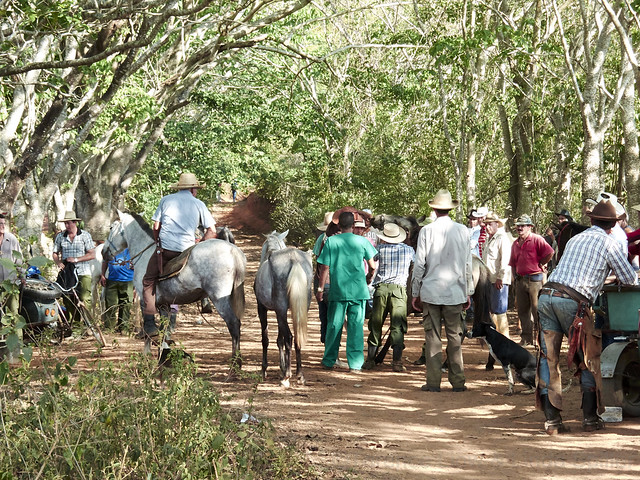
The Cuban government sends vets out to the field to take care of the people's livestock. Horses were being brought to this rural lane for a heath check up.
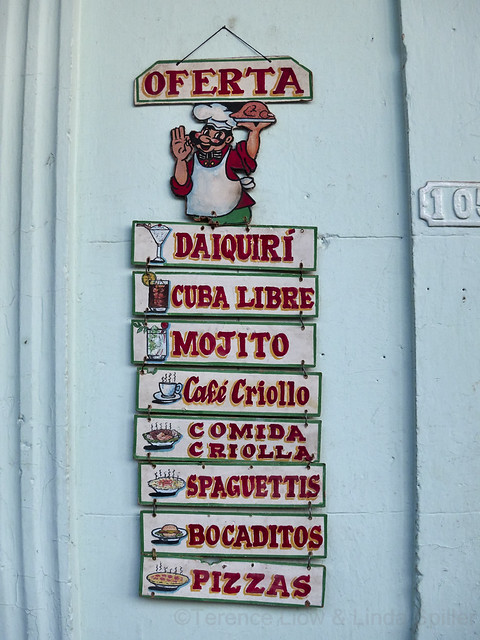 The menu
The menu
at a bar in Vinales
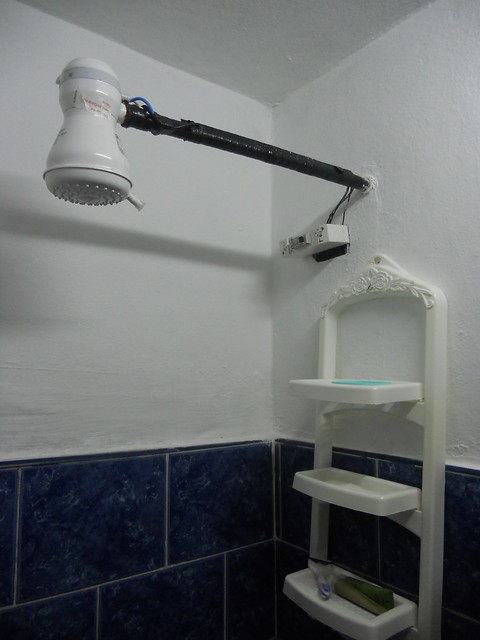 The famous Cuban electric shower
The famous Cuban electric shower
Actually designed and made in Brasil, 110 volts in the shower head gives you rather warm water. Note the location of the circuit breaker switch on the wall.

This hotel is the place to stay in Vinales (though a little bit isolated). Nearly impossible to get into as it is booked out by tour groups

Dawn in Vinales. It's nice to walk around these limestone hills.
 Farm gate store
Farm gate store Beans being dried by the campesino. The family has a nice CP with 2 rooms.
Beans being dried by the campesino. The family has a nice CP with 2 rooms. Dried tobacco
Dried tobaccoThe best stuff is said to be grown here

The Cuban government sends vets out to the field to take care of the people's livestock. Horses were being brought to this rural lane for a heath check up.
 The menu
The menuat a bar in Vinales
 The famous Cuban electric shower
The famous Cuban electric showerActually designed and made in Brasil, 110 volts in the shower head gives you rather warm water. Note the location of the circuit breaker switch on the wall.
Last edited by YVR Cockroach; Jan 27, 2017 at 6:10 pm
#8
FlyerTalk Evangelist
Original Poster
Join Date: Nov 1999
Programs: FB Silver going for Gold
Posts: 21,801
After two nights in Vinales, we started out trip to the eastern end of Cuba.

Bridges to nowhere are by no means unique to wherever you live (on the highway between Pinar del Rio and Havana)
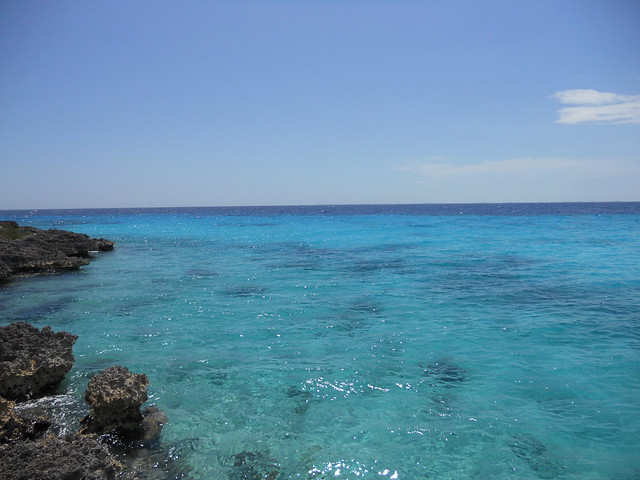
After turning off at a village called, IIRC Australia, we got to the Bay of Pigs. Water is beautiful but hard to get in (rocky shores).
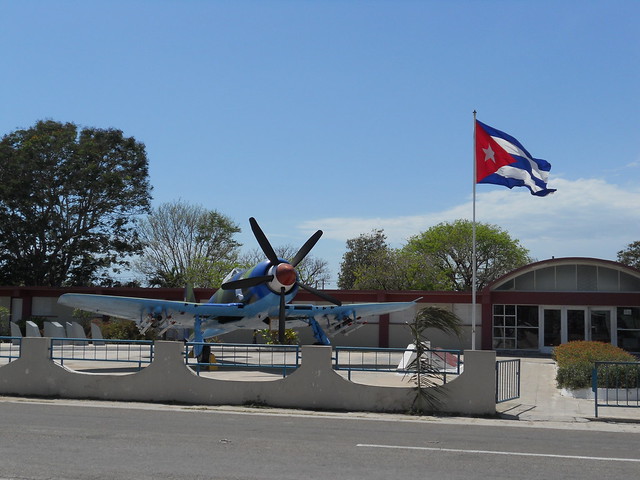 Bay of Pigs Museum
Bay of Pigs Museum

Bridges to nowhere are by no means unique to wherever you live (on the highway between Pinar del Rio and Havana)

After turning off at a village called, IIRC Australia, we got to the Bay of Pigs. Water is beautiful but hard to get in (rocky shores).
 Bay of Pigs Museum
Bay of Pigs Museum
#9
FlyerTalk Evangelist
Original Poster
Join Date: Nov 1999
Programs: FB Silver going for Gold
Posts: 21,801
Casa Particulares
There are two varieties. The blue sign one for tourists and those who can pay in CUCs, and the red ones for those who pay in CUPs.
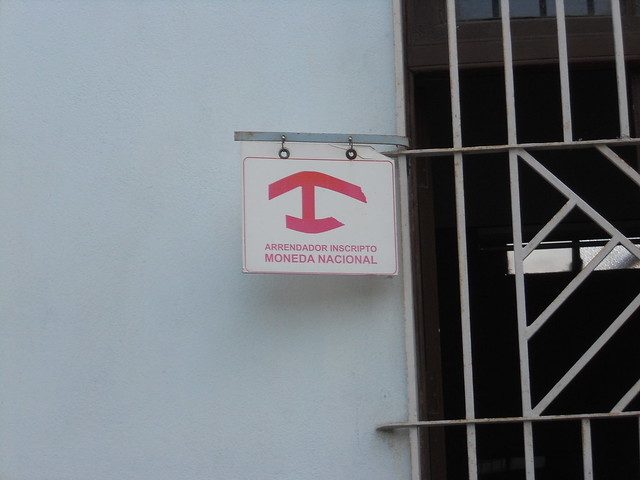 Casa Particular for Cubans
Casa Particular for Cubans
Probably saw one of these for every 100-odd blue ones

Sign for the CP for the likes of you and me. Surprisingly numerous.
 Casa Particular for Cubans
Casa Particular for Cubans Probably saw one of these for every 100-odd blue ones

Sign for the CP for the likes of you and me. Surprisingly numerous.





















